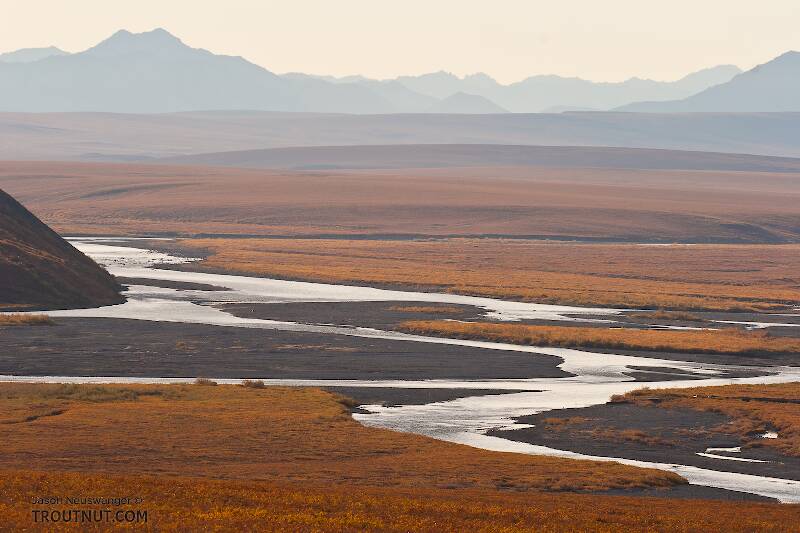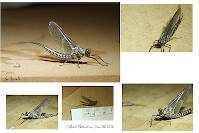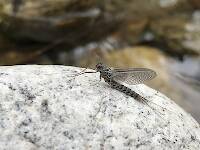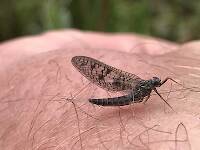
Blue-winged Olives
Baetis
Tiny Baetis mayflies are perhaps the most commonly encountered and imitated by anglers on all American trout streams due to their great abundance, widespread distribution, and trout-friendly emergence habits.
Featured on the forum

Some characteristics from the microscope images for the tentative species id: The postero-lateral projections are found only on segment 9, not segment 8. Based on the key in Jacobus et al. (2014), it appears to key to Neoleptophlebia adoptiva or Neoleptophlebia heteronea, same as this specimen with pretty different abdominal markings. However, distinguishing between those calls for comparing the lengths of the second and third segment of the labial palp, and this one (like the other one) only seems to have two segments. So I'm stuck on them both. It's likely that the fact that they're immature nymphs stymies identification in some important way.

Troutnut is a project started in 2003 by salmonid ecologist Jason "Troutnut" Neuswanger to help anglers and
fly tyers unabashedly embrace the entomological side of the sport. Learn more about Troutnut or
support the project for an enhanced experience here.
Sayfu
Posts: 560
Posts: 560
Sayfu on Sep 28, 2011September 28th, 2011, 4:59 am EDT
Darn proper word had me confused as to what they were talking about! I learn the bugs, as they apply to my fishing, and know a number of the latin propers, but a river I fish on occasion, and it is a great river that is under fished, IMO, in Montana, is the Clark Fork River. My fly shop in St. Regis, MT said that Hecuba was on the water. I thought it was attached to the green drakes, the few rivers that have our Western Green Drake in the Fall. Dug through my books, and it is part of the Western Green Drakes that emerge in the Fall, but also a Western Sulphur?? I'm thinking it is what I would identify as a Pale Evening Dun, the long, two tailed, light bodied bugs we identify as Epeorus Albertae. Could both be on our water in late Summer? I have never heard the wold Hecuba used on our SF of the Snake. There is a Western Green Drake on a trib of the SF, and a few rivers in Yellowstone Park, like Slough Creek, that gets the Fall hatch of Green Drakes.
Taxon on Sep 28, 2011September 28th, 2011, 7:58 am EDT
Jere-
Timpanoga hecuba is a large Ephemerellid which authors Rick Hafele and Dave Hughes refer to as Great Blue-Winged Red Quill in their excellent book, Western Mayfly Hatches. The nymph is really distinctive shaped. Here is a ventral view of one I collected from the S. Fork of the Snoqualmie River in WA:
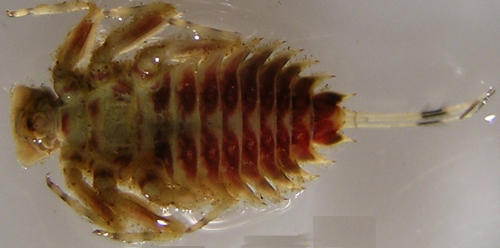
Timpanoga hecuba is a large Ephemerellid which authors Rick Hafele and Dave Hughes refer to as Great Blue-Winged Red Quill in their excellent book, Western Mayfly Hatches. The nymph is really distinctive shaped. Here is a ventral view of one I collected from the S. Fork of the Snoqualmie River in WA:

Entoman on Sep 28, 2011September 28th, 2011, 8:00 am EDT
Sayfu -
Timpanoga hecuba hecuba (Great Red Quill) is a large ephemerellid that can occasionally produce fishable hatches. It's a scary looking bugger with it's large lateral spines. They look like an E. grandis (Western Green Drake) on steroids. They're big! They are fully as long as grandis but much stouter.
The genus currently consists of only two subspecies, the other being hecuba pacifica. My experience with them is on streams draining the eastern slope of the Sierras. They seem to prefer silty areas in cobble bottoms and population densities seem to run counter to E. grandis. The years I've seen them in good numbers is during drought conditions when the spring runoff fails to flush things out well. I believe they tend to be sporadic hatchers which may explain why the nymph populations can often be empressive while there emergences remain sparse.
Regards,
Kurt
Timpanoga hecuba hecuba (Great Red Quill) is a large ephemerellid that can occasionally produce fishable hatches. It's a scary looking bugger with it's large lateral spines. They look like an E. grandis (Western Green Drake) on steroids. They're big! They are fully as long as grandis but much stouter.
The genus currently consists of only two subspecies, the other being hecuba pacifica. My experience with them is on streams draining the eastern slope of the Sierras. They seem to prefer silty areas in cobble bottoms and population densities seem to run counter to E. grandis. The years I've seen them in good numbers is during drought conditions when the spring runoff fails to flush things out well. I believe they tend to be sporadic hatchers which may explain why the nymph populations can often be empressive while there emergences remain sparse.
Regards,
Kurt
"It's not that I find fishing so important, it's just that I find all other endeavors of Man equally unimportant... And not nearly as much fun!" Robert Traver, Anatomy of a Fisherman
Entoman on Sep 28, 2011September 28th, 2011, 8:07 am EDT
Taxon - Beat me by two minutes! Why am I not surprised...:)
Sayfu - Taxon's picture makes my point, don't you think?
Regards,
Kurt
Sayfu - Taxon's picture makes my point, don't you think?
Regards,
Kurt
"It's not that I find fishing so important, it's just that I find all other endeavors of Man equally unimportant... And not nearly as much fun!" Robert Traver, Anatomy of a Fisherman
Sayfu
Posts: 560
Posts: 560
Sayfu on Sep 28, 2011September 28th, 2011, 4:00 pm EDT
Darn! Lost my post again. I went back to my Craig Mathews book on Yellowstone hatches, a bible for me out here in Eastern Idaho. Here is what he says on green drakes. They are found emerging from June to Sept. And the reason why is the various species of Green Drakes..all closely related taxonomically, but vary in appearance according to the time of year they emerge. There is Drunella grandis, Drunella doddsi, Drunella coloradensis, and Timpanoga hecuba that emerges in the Fall on the Lamar, Soda Butte, and Slough Creek. All 4 species are present on the Gallatin he said. I had flashbacks from reading this on Green Drakes in his book, and now I hear hecuba referred to as a large mayfly. After seeing your pictures I would say that Craig Mathews was wrong, but I would never tell him that!
Entoman on Sep 28, 2011September 28th, 2011, 5:56 pm EDT
Sayfu -
Don't you hate that!
BTW, Craig Matthews wasn't necessarily wrong. It depends on when he wrote his book. They were all species in the Ephemerella genus not all that long ago. Regardless, it is common practice for authors to group the big western ephemerellids together for practical reasons. Excepting its reddish brown body, T. hecuba duns look very much like Drunella grandis in both shape and size.
It is a little puzzling that he included D. coloradensis with this group. It is usually associated with D. flavilinea. The two are very hard to tell apart and go by the common names Western Blue-winged Olive or "Flav" (ugh). Perhaps he did because many call these mid-sized olives the oxymoronic name Small Green Drake?
For grins (and future reference), here's a list of the more common western blue-winged olive ephemerellids and their average sizes, starting with the biggest first. There are a few more species that could be included and some Pale Morning Duns can blur the lines in many watersheds.
Drunella Grandis sub-species 15mm
D. doddsi 13mm
D. spinifera 12mm
D. coloradensis 11mm
D. flavilinea 10mm
Caudatella heterocaudatus 8mm
Attenella margarita 6mm
Taken together, they pretty much have the size ranges covered from #8 to #18. :)
Regards,
Kurt
Darn! Lost my post again...
BTW, Craig Matthews wasn't necessarily wrong. It depends on when he wrote his book. They were all species in the Ephemerella genus not all that long ago. Regardless, it is common practice for authors to group the big western ephemerellids together for practical reasons. Excepting its reddish brown body, T. hecuba duns look very much like Drunella grandis in both shape and size.
It is a little puzzling that he included D. coloradensis with this group. It is usually associated with D. flavilinea. The two are very hard to tell apart and go by the common names Western Blue-winged Olive or "Flav" (ugh). Perhaps he did because many call these mid-sized olives the oxymoronic name Small Green Drake?
For grins (and future reference), here's a list of the more common western blue-winged olive ephemerellids and their average sizes, starting with the biggest first. There are a few more species that could be included and some Pale Morning Duns can blur the lines in many watersheds.
Drunella Grandis sub-species 15mm
D. doddsi 13mm
D. spinifera 12mm
D. coloradensis 11mm
D. flavilinea 10mm
Caudatella heterocaudatus 8mm
Attenella margarita 6mm
Taken together, they pretty much have the size ranges covered from #8 to #18. :)
Regards,
Kurt
"It's not that I find fishing so important, it's just that I find all other endeavors of Man equally unimportant... And not nearly as much fun!" Robert Traver, Anatomy of a Fisherman
Sayfu
Posts: 560
Posts: 560
Sayfu on Sep 28, 2011September 28th, 2011, 6:10 pm EDT
Thanks, you have made me remember that I have read that coloradensis is closely associated with Flavilinia, and flavs as I know them. They can come off well on cloudy mid to late afternoons on the Henry's Fork. And Mathew's book on Yellowstone hatches has been out for some years now. Interesting that you say the body color of hecuba is a reddish brown. I listened to the streamer guy, Kelly Gallop give a hatch presentation for the Madison, and he recommended tying Green Drake patterns in a maroon body color as well as the olive body with yellow segmentation. He said that once the green drakes are on the water for a short time they turn maroon in color.
Entoman on Sep 28, 2011September 28th, 2011, 7:05 pm EDT
Yeah, the drunella genus is notorious for darkening pretty quick and Green Drakes often do change from a bright green to a dull brownish olive (edit: not while still on the water, see commentary below). But maroon? Sounds like hecuba to me. Like assuming that PMD's are a single multi-brooded species that gets progressively smaller in baetid fashion, there is a little confusion about these matters in some angling circles.
"It's not that I find fishing so important, it's just that I find all other endeavors of Man equally unimportant... And not nearly as much fun!" Robert Traver, Anatomy of a Fisherman
GONZO on Sep 28, 2011September 28th, 2011, 7:50 pm EDT
Entoman on Sep 28, 2011September 28th, 2011
Gonzo -
Yes, and I've seen them look almost black as well, but many hours later when they're ready to molt, as in the case of the photo you linked. We're talking about duns after the first seconds of emergence when they are available for munching. Do the eastern Drunella species get this dark before molting?
Jere -
Nope, not in my experience.
Yes, and I've seen them look almost black as well, but many hours later when they're ready to molt, as in the case of the photo you linked. We're talking about duns after the first seconds of emergence when they are available for munching. Do the eastern Drunella species get this dark before molting?
Jere -
He said that once the green drakes are on the water for a short time they turn maroon in color.
Nope, not in my experience.
"It's not that I find fishing so important, it's just that I find all other endeavors of Man equally unimportant... And not nearly as much fun!" Robert Traver, Anatomy of a Fisherman
Sayfu
Posts: 560
Posts: 560
Sayfu on Sep 29, 2011September 29th, 2011, 6:03 am EDT
Taxon..We use to live on Mercer Island at the light on Island Crest Way and 40th if the light is still there. I have fished the SF of the Snoqualmie many times fishing the Middle Fork more though in the later years. And an interesting note on Green Drakes, and the SF of the Snoqualmie. Not far from the SF I had some of the finest Green Drake fishing going...below the Ensign Ranch not far below the headwaters of the Yakima. All the big fish in that section of river would be up on them, and there were some very big rainbows in that section. First week of June was the timing. The riparian must have been favorable for them. You don't find them below that upper section I do not believe, and the riparian zone changes below Cle-Elem.
Taxon on Sep 29, 2011September 29th, 2011, 7:33 am EDT
Interesting, Jere. Thanks for sharing. Incidentally, the pictured nymph was collected adjacent to the parking lot for the Twin Falls trailhead.
Sayfu
Posts: 560
Posts: 560
Sayfu on Aug 14, 2012August 14th, 2012, 6:39 am EDT
Months later..and I am finally learning how to use this great sight. I have always been very visual, and this site has really upgraded my bug ID from terrible to poor which is a quantum leap. Hughes, in his new book, refers to timpanoga hecuba as a Green Drake (common name), and saying the two are related, and the same flies can be used for both.
Quick Reply
Related Discussions
Topic
Replies
Last Reply
4
Jun 17, 2020
by Leskorcala
by Leskorcala
2
Aug 2, 2019
by Crepuscular
by Crepuscular
6
Jun 10, 2009
by Martinlf
by Martinlf
Re: Best of the Forum--Most Useful and Informative Bug Threads Featured Topic
In General Discussion by Martinlf
In General Discussion by Martinlf
17
Feb 26, 2016
by Crepuscular
by Crepuscular
23
Apr 12, 2012
by Entoman
by Entoman

